全国2010年1月高等教育自学考试教育学原理(00469)试题
全国2010年1月自学考试教育管理原理试题
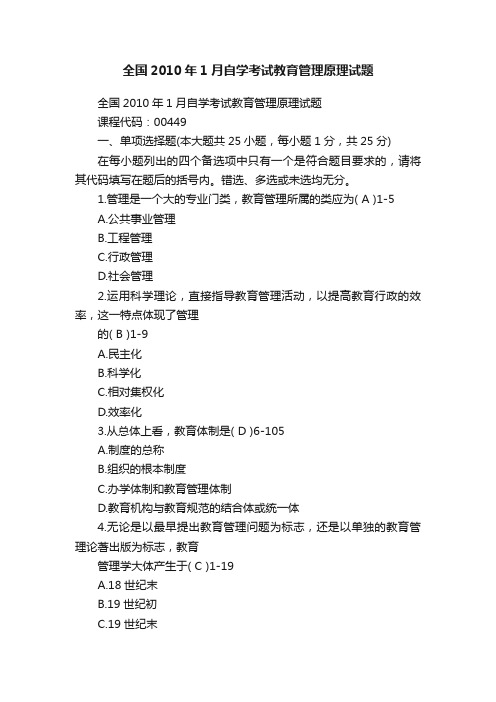
全国2010年1月自学考试教育管理原理试题全国2010年1月自学考试教育管理原理试题课程代码:00449一、单项选择题(本大题共25小题,每小题1分,共25分)在每小题列出的四个备选项中只有一个是符合题目要求的,请将其代码填写在题后的括号内。
错选、多选或未选均无分。
1.管理是一个大的专业门类,教育管理所属的类应为( A )1-5A.公共事业管理B.工程管理C.行政管理D.社会管理2.运用科学理论,直接指导教育管理活动,以提高教育行政的效率,这一特点体现了管理的( B )1-9A.民主化B.科学化C.相对集权化D.效率化3.从总体上看,教育体制是( D )6-105A.制度的总称B.组织的根本制度C.办学体制和教育管理体制D.教育机构与教育规范的结合体或统一体4.无论是以最早提出教育管理问题为标志,还是以单独的教育管理论著出版为标志,教育管理学大体产生于( C )1-19A.18世纪末B.19世纪初C.19世纪末D.20世纪初5.系统论认为,世间一切事物都是以系统的形式存在的,系统内各要素之间是相互依存、相互制约的关系,即系统具有( C )2-33A.层次性B.集合性C.相关性D.稳定性6.20世纪中期以后,很多国家开始调整教育管理的职能,集权制国家松动集权模式的做法是( D )2-36A.法国于1968年颁布了《高等教育方向指导法案》,将国家管理教育的部分职能交给学校B.日本于1947年颁布了《教育基本法》C.英国较早成立了皇家督学团D.美国于1979年成立了中央一级的教育部7.要完成从传统的监督型职能向“指导——监督”型职能转变,第一,要强化立法职能,第二,要强化( D )2-41A.经营职能B.监督职能C.计划职能D.指导服务职能8.按照教育行政人员的工作实绩和贡献进行赏罚,是教育人事行政的( A )7-141A.论功行赏原则B.因事择人原则C.任人唯贤原则D.合理流动原则9.建立在权力和责任基础上由上级对下级下达必须遵照执行的任务、要求和命令的方法是3-53( A )A.组织调度的方法B.法治的方法C.预测规划的方法D.协调激励的方法10.曾对西方文官制度的形成产生过重大影响的我国历史上的人才选用制度是( D )7-144A.贡举制B.九品中正制C.察举制D.科举制11.教育法规具有很强的阶级性,这是教育法规最根本的( B )4-71A.表现形式B.本质特征C.精神实质D.制定依据12.教育政策的构成要素包括( C )4-65A.政策对象、政策目标B.政策目标及实现目标的手段C.政策的对象、目标、手段三位一体D.政策的中心、原则、步骤三位一体13.对教材内容预测时,既要对未来教材可能容纳大量新知识的先进性做充分的分析,又要遵循学生掌握知识的客观规律,不可对教材内容的变化做过分超前的估计。
教育学原理自考试题及答案
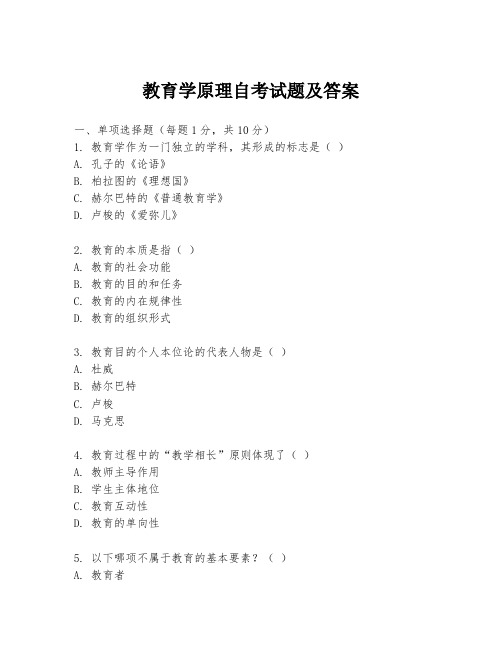
教育学原理自考试题及答案一、单项选择题(每题1分,共10分)1. 教育学作为一门独立的学科,其形成的标志是()A. 孔子的《论语》B. 柏拉图的《理想国》C. 赫尔巴特的《普通教育学》D. 卢梭的《爱弥儿》2. 教育的本质是指()A. 教育的社会功能B. 教育的目的和任务C. 教育的内在规律性D. 教育的组织形式3. 教育目的个人本位论的代表人物是()A. 杜威B. 赫尔巴特C. 卢梭D. 马克思4. 教育过程中的“教学相长”原则体现了()A. 教师主导作用B. 学生主体地位C. 教育互动性D. 教育的单向性5. 以下哪项不属于教育的基本要素?()A. 教育者B. 受教育者C. 教育内容D. 教育环境6. 教育心理学研究表明,学生的认知发展阶段理论是由()提出的。
A. 皮亚杰B. 弗洛伊德C. 埃里克森D. 斯金纳7. 现代教育技术中,信息技术在教育中的应用不包括()A. 多媒体教学B. 远程教育C. 课堂教学D. 传统板书8. 根据布鲁姆的教育目标分类,认知领域的目标不包括()A. 知识B. 理解C. 应用D. 情感9. 教育评价的功能主要包括()A. 选拔与鉴定B. 促进与激励C. 反馈与调整D. 以上都是10. 终身教育的概念最早是由()提出的。
A. 保罗·朗格朗B. 约翰·杜威C. 马克斯·韦伯D. 埃米尔·涂尔干二、多项选择题(每题2分,共10分)11. 教育的三大基本规律包括()A. 教育与社会发展的规律B. 教育与个体发展的规律C. 教育与经济的规律D. 教育与政治的规律12. 以下哪些属于教育的显性功能?()A. 促进经济增长B. 培养人才C. 传承文化D. 促进社会稳定13. 教育活动中的师生关系应该体现为()A. 权威与服从B. 民主平等C. 相互尊重D. 单向传授14. 教育研究方法中的质性研究方法包括()A. 观察法B. 访谈法C. 问卷调查D. 案例研究15. 教育评价的基本原则包括()A. 客观性原则B. 发展性原则C. 指导性原则D. 单一性原则三、判断题(每题1分,共5分)16. 教育学是一门理论性与实践性相结合的学科。
00469教育学原理201010真题及答案
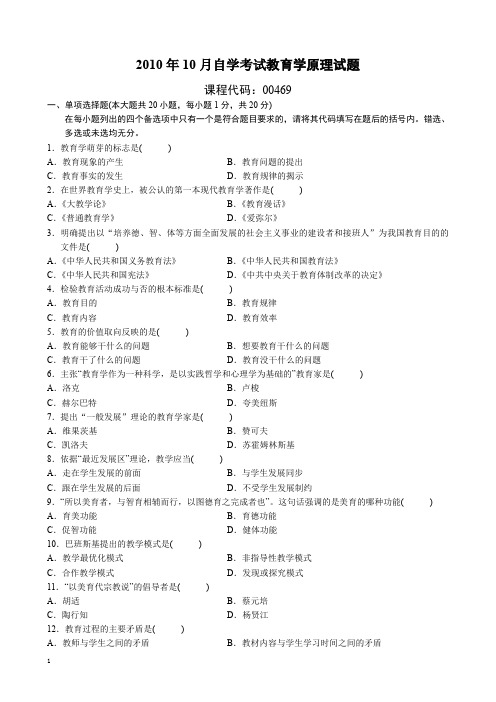
2010年10月自学考试教育学原理试题课程代码:00469一、单项选择题(本大题共20小题,每小题1分,共20分)在每小题列出的四个备选项中只有一个是符合题目要求的,请将其代码填写在题后的括号内。
错选、多选或未选均无分。
1.教育学萌芽的标志是( )A.教育现象的产生B.教育问题的提出C.教育事实的发生D.教育规律的揭示2.在世界教育学史上,被公认的第一本现代教育学著作是( )A.《大教学论》B.《教育漫话》C.《普通教育学》D.《爱弥尔》3.明确提出以“培养德、智、体等方面全面发展的社会主义事业的建设者和接班人”为我国教育目的的文件是( )A.《中华人民共和国义务教育法》B.《中华人民共和国教育法》C.《中华人民共和国宪法》D.《中共中央关于教育体制改革的决定》4.检验教育活动成功与否的根本标准是( )A.教育目的B.教育规律C.教育内容D.教育效率5.教育的价值取向反映的是( )A.教育能够干什么的问题B.想要教育干什么的问题C.教育干了什么的问题D.教育没干什么的问题6.主张“教育学作为一种科学,是以实践哲学和心理学为基础的”教育家是( )A.洛克B.卢梭C.赫尔巴特D.夸美纽斯7.提出“一般发展”理论的教育学家是( )A.维果茨基B.赞可夫C.凯洛夫D.苏霍姆林斯基8.依据“最近发展区”理论,教学应当( )A.走在学生发展的前面B.与学生发展同步C.跟在学生发展的后面D.不受学生发展制约9.“所以美育者,与智育相辅而行,以图德育之完成者也”。
这句话强调的是美育的哪种功能( ) A.育美功能B.育德功能C.促智功能D.健体功能10.巴班斯基提出的教学模式是( )A.教学最优化模式B.非指导性教学模式C.合作教学模式D.发现或探究模式11.“以美育代宗教说”的倡导者是( )A.胡适B.蔡元培C.陶行知D.杨贤江12.教育过程的主要矛盾是( )A.教师与学生之间的矛盾B.教材内容与学生学习时间之间的矛盾C.教学环境与教学活动之间的矛盾D.培养目标与学生发展实际之间的矛盾13.学生生理和心理发展的“危机期”是指( )A.童年期B.少年期C.青年初期D.青年晚期14.我国学制中具有明显半殖民地半封建性质的学制是( )A.癸卯学制B.壬子—癸丑学制C.壬戌学制D.1951年学制15.教育受社会影响,但社会不能完全改变教育内在发展的规律,这表明教育具有( )A.环境决定性B.相互排斥性C.相对独立性D.内部同一性16.学校体育的主要功能有:健体功能、教育功能和( )A.娱乐功能B.竞技功能C.育德功能D.审美功能17.人类最早的学校出现在公元前2500年左右的哪个国家( )A.中国B.印度C.巴比伦D.埃及18.教育过程是一个上位概念,它具体包括:德育过程、智育过程、美育过程和( )A.艺术过程B.体育过程C.人文过程D.科学过程19.杜威是下列哪种理论的代表人物( )A.课堂中心论B.知识中心论C.教师中心论D.儿童中心论20.发挥联系学校与社会桥梁作用的教育形式是( )A.学前教育B.成人教育C.家庭教育D.社区教育二、名词解释题(本大题共5小题,每小题4分,共20分)21.教育目的22.智育23.单轨制24.教育的公平性25.实用主义教育学三、简答题(本大题共6小题,选答其中4小题,每小题8分,共32分,多选答者,按前4小题评分) 26.我国德育的内容主要有哪些?27.学校教育的基本要素包括哪些方面?28.简述教育的生产性。
教育学原理历年真题(The education principle over the years)
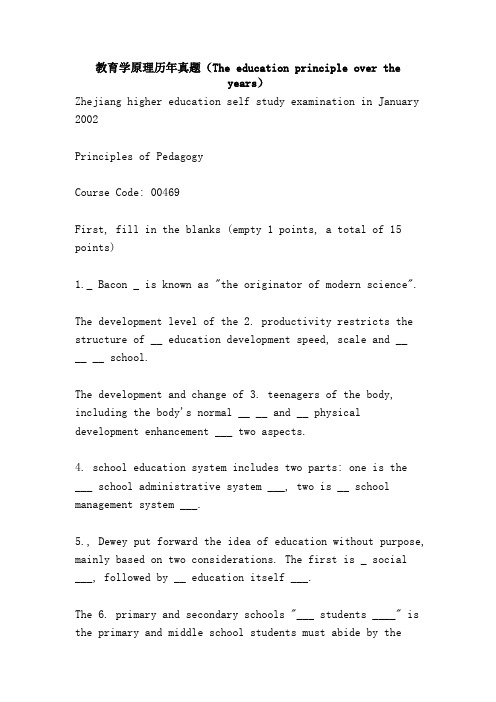
教育学原理历年真题(The education principle over theyears)Zhejiang higher education self study examination in January 2002Principles of PedagogyCourse Code: 00469First, fill in the blanks (empty 1 points, a total of 15 points)1._ Bacon _ is known as "the originator of modern science".The development level of the 2. productivity restricts the structure of __ education development speed, scale and ____ __ school.The development and change of 3. teenagers of the body, including the body's normal __ __ and __ physical development enhancement ___ two aspects.4. school education system includes two parts: one is the___ school administrative system ___, two is __ school management system ___.5., Dewey put forward the idea of education without purpose, mainly based on two considerations. The first is _ social___, followed by __ education itself ___.The 6. primary and secondary schools "___ students ____" is the primary and middle school students must abide by thecode of conduct.7. school education mainly through the ____ __ intellectual culture _ and ____ activities to achieve.8. by setting a certain situation to make studentsnaturally have a teaching method called ___ cultivation method _____ education.9. student center theory mainly in France and the United States _____ ___ Rousseau as the representative of Dewey.10. students' ideas, personality, and the resulting behavior is affected by ___ social influence and restrict the __.Two, single choice (in each item of four answer options, choose a correct answer, the correct answer and fill in the numbers in parentheses. Every day 1 points, a total of 10 points)1. generally speaking, it is considered the first pedagogical work to be (c)A. "the Republic"B. "learning notes"C. "great pedagogy"D. "general pedagogy"2. the culture is transferred from one generation to another in the same social and cultural community. This function is called aA. education transfer preservation cultural functionB. education communication cultural functionC. educational choice enhance cultural functionD. educational creation renew cultural function3. "the wolf howl." It shows that B plays an important role in the development of human beings.A. geneticB. environmentC. education,D., subjective initiative4. "some children have deep and lasting emotions, while some children are unrestrained and enthusiastic." This shows that the physical and mental development of teenagers (d)A. sequentialB. disequilibriumC. variabilityD. individual variability5. "seven arts" refers to (d)A. grammar, rhetoric, dialectics, arithmetic, geometry, astronomy, archeryB. grammar, law, dialectics, arithmetic, geometry, astronomy, musicC. grammar, rhetoric, oratory, arithmetic, geometry, astronomy, archeryD. grammar, rhetoric, dialectics, arithmetic, geometry, astronomy, music6. the educational teleology put forward by Emile Durkheim belongs to (b)A. theological education teleology --B. society based educational teleologyC. individual oriented educational teleology --D. education without aim theory7. school sports can make the students in the physical and mental after recovery and relaxation. It means DA. fitness functionB. intellectual functionC. Germany functionD. entertainment function8. Hirooka Ryohide in Japan summed up the educational process as (c)A. preparation -- Internalization -- Consolidation ofB. hypothesis -- verification -- SummaryC. introduction -- unfolding -- endingD. preparation -- Internalization -- Application9.. The main representative of Teacher centered theory is(d)A. Platon RousseauB.C. Dewey HerbartD.The formation of the personality quality of the 10. people is mainly through (a)(1) monorail system(2) combination of unity and flexibility(3) the combination of general education and Vocational Education(4) the combination of formal education and informal education3. factors affecting the determination of educational content.(1) social situation and its development(2) the development of culture and science and technology(3) the reality of educational objects(4) teachers' values, knowledge level and personality characteristics4. characteristics of family education.(1) the life style of family education(2) the emotional education of family education(3) diversification of family educationSeven, discuss a problem (to match each 10 points, a total of 20 points)1. comment on experimental pedagogy.(1) time: Europe and America at the end of the twentieth Century and the beginning of nineteenth Century(2) representative: Mei Iman(3) main points of view:A opposed to Herbart as the representative of the emphasis on the concept of education, that education in test methods is of no use to learn this kind of education;B advocates applying the research results and methods of experimental psychology to educational research, so as to make educational research truly scientific";C education experiment must be divided into three stages: the hypothesis of a problem; the experiment plan accordingto the hypothesis; the experiment; the experimental results applied to the actual, to prove its correctness;D believes that the difference between education experiment and psychological experiment is that psychological experiment is carried out in the laboratory, while education experiment should be carried out in the real school environment and teaching practice;E advocates to explore the characteristics of children's psychological development and the level of intelligence development by means of experiment, statistics and comparison, and uses experimental data as the basis for reforming the educational system, curriculum and teaching methods.(4) evaluationThe quantitative research emphasized by A experimental education has become a basic paradigm of educational research in the twentieth Century. It has been widely used and developed in the past hundred years, which has greatly promoted the development of educational science.The limitations of B Experimental Pedagogy: some problems can not be dealt with by experiments or quantitative methods, so it is possible to go towards scientism.2. discuss the history of the establishment and development of school education system in our country. What experience can we get from it? What are the implications for thecurrent school system reform in China?(I) history(1) 1902~1904 year schooling system(2) 1912~1913 year schooling system(3) 1922 educational system(4) 1951 educational system(5) the system of schooling after the Third Plenary Session of the CPC Central Committee(6) the educational system in 1985(two) experience(1) the modern educational system should not only consider the nature of social productive relations, but also consider the social productive forces and the level of science and technology development.(2) the educational system reform to go its own way, cannot become the foreign educational system reform "yesman", or pull a rickshaw on the issue of "the educational system reform".(3) the reform of school system should be scientific and rational.(three) enlightenmentOpen the answer, as long as you can It stands to reason.National self taught higher education examination in October 2001Principles of PedagogyCourse Code: 00469The first part of the multiple-choice questionA single choice (the title of 20 items, each item of 1 points, a total of 20 points) in four options for each item listed onlyOne option is in line with the requirements of the subject. Please insert the letter before the correct option in the brackets after the question.1. the representative of the social standard educational teleology is (A)A. B. C. Zankov Rousseaus Durkheim D. Frobel2., the teacher's language as the main media, systematic, coherent to impart knowledge to students, express emotion and values of education methodsYes (B)A. demonstration method,B. teaching method,C. conversation method,D. cultivation method3. from the time point of view,Compared with other forms of education, family education is characterized by (B)A. begins the earliest and lasts the shortest.B. begins the longest and lasts the longestC. started late and lasted the longest,D. started late and lasted for a short time4. "three centers" in traditional teaching means DA. student center, activity center, life center,B. student center, social center and Practice CenterC. teacher center, practice center, life center,D. teacher center, classroom center, textbook Center5., the core position in the school education system is (C)A. logistics work,B. management work,C. teaching work,D. scientific research work6. the direct function of aesthetic education is (C)A. ethicsB. promote wisdomC. beautyD. fitness7., the amount of education investment in a country depends on (C)A. cultural tradition,B. educators' needs,C. productivity level,D. education scale8. the most fundamental and intrinsic factor that causesand determines the development and change of education is (A)A. social productivity,B. cultural tradition,C. social system,D. science and technology level9. the earliest private schools in China flourished (B)A. Shang ZhouB., spring and autumn, Warring States period,C., Qin and Han,D., Sui and Tang Dynasties10. in the theory of teacher student relationship, the representative of "child centered theory" is (C)A. B. C. Dewey D. Herbart Pestalozzi ComeniusThe physical and mental development of the 11. refers to (A)A. physical and psychological development,B. personality formation of moral characterC. weight and height increaseD. skills and skills12. the following characteristics of education in the primitive society are (C)A. systematicness,B., institutionalC., non class nature,D. hierarchy13.. Modern schools in China arise from (C)A.17 century end,B.18 century end,C.19 century end,D.20 century end14., on the issue of the origin of education, it is believed that the birth of education is entirely from the point of view of animal instinct (A)A. biological origin theory,B. myth origin theory,C. psychological origin theory,D. labor origin theory15. the fundamental task of intellectual education is (A)A. developing students' intelligenceB. and cultivating students' AutonomyC. to improve students' interest in life,D. to form students' conduct16. compared with general physical exercise, school sports are more (D)A. randomness,B. entertainment,C. consciousness,D.systematicnessThe world outlook of the 17. people is basically formed in (D)A. infancyB. childhoodC. adolescenceD. youth18. teachers are the organizers and leaders of educational activities, and they play an important role in the process of Education (C)A. compulsion,B. helper effect,C. dominance,D. mediation19. the educational work of Rousseau, a famous French educator, is (C)The "B. A." education "teaching" C. "Emile" D. "general education"20. the modern school education system in Britain is a typical one (A)A. double track systemB. monorailC. branchD. intermediate educational systemThe second part is the non selective questionTwo, (the title glossary 4 items, each item of 5 points, a total of 20 points)21. educational policyIt is the policy expression of educational purpose, the general requirement of a country's education work, and the root of a country's educationThis nature, the general guiding ideology and the general direction of education work.22. educational methodsTeachers and students in the process of education in order to achieve certain educational goals and the use of some internal relations activitiesCombination of means and means23. educational influenceIn the process of education, all the information that educators use to students includes both the content of information and the informationThe form of transmission and feedback is the unity of form and content24. moral educationIt is the value environment for the educators to organize the moral growth of the moral objects and promote them in morality, thought and PoliticsEducational activities that are constantly constructed and promotedThree, short answer questions (the big topic 4 items, each item of 8 points, a total of 32 points)25. why does education play a leading role in the development of human beings?(1) education is a kind of purposeful, planned, organized and systematic training of human activities;(2) education is a teacher's influence on teenagers according to the requirements of a certain social development to promote their freedomAll round development activities;(3) in a person's life, adolescence is the most necessary period of education and the best education.26. characteristics of modern education.The characteristics of modern education include:(1) the publicity of modern education;(2) the productive nature of modern education;(3) the scientific nature of modern education;(4) the future of modern education;(5) the international nature of modern education;(6) the lifelong character of modern education;(7) the revolutionary of modern education.27. the basic characteristics of educational objectives in china.(1) the purpose of education in China is guided by the theory of Marx's all-round development of human beings;(2) the educational purpose of our country has distinct political direction;(3) adhere to the unity of overall development and individual development;28. what are the constraints and decisive roles of the political system on education?1) the political system has the restriction and the decisive function to the education goal and the education content;(2) the political system determines the leadership of education and restricts who has the right to receive education and what kind of EducationFour, discussion questions (13 points)29. contact with practice, discusses what basic qualities teachers should have?(1) good ideological and moral accomplishment. It includesa firm political orientation, dedication to education, respect and warmthLove students, spirit of teamwork, and teacher Yanyilvji, etc..(2) reasonable knowledge structure. It includes systematic Marxist Leninist theory, profound professional knowledge and extensive knowledgeThe basic knowledge of culture and the necessary knowledge of educational science.(3) proper ability structure. Including the ability to organize education and teaching activities, language expression ability, organization and management ability,And the ability to control themselves.Five, case analysis (15 points)Five, case analysis (this topic 15 points)30. Guangming school is a weak school, students do not go to school, illegal activities occur from time to time,academic performance has been comparedWorse. In 1994, President Li worked in the school, determined to change this situation, designed on the basis of investigation and researchTaking aesthetic education as the breakthrough point to promote the reform program of school development. The specific way of the school is, in the good music, art classOn the basis of this, each student is required to participate in extracurricular art clubs or activities of interest groups, and the school drum orchestra is established,The choir, calligraphy society, art club, craft group and other art groups, art education run regular lectures, heldCampus art festival, timely exhibition and exhibition of artistic community achievements.After a period of hard work, school artThe education activities are in full swing, the students are bored with it, and the whole face of the school has changed, the offenseThe crime will not happen, academic performance is obviously improved, the spirit of the students has changed the face of.Question: (1) apply the principle of aesthetic education to analyze the reform measures of Guangming school;(1) the function of aesthetic education is: direct function, indirect function, super aesthetic education function (or moral education, intelligence promotion, health andaesthetic appreciation),Cultivate creativity, etc.. The reform experience of Guangming school with aesthetic education as the breakthrough point is mainly the comprehensive applicationof aesthetic educationEducation function, that is, aesthetic education can cultivate people's temperament and promote students' moral and intellectual progress. The school notesTeachers change research, through a variety of aesthetic activities to change their appearance, has a positive meaning.(2) if you are a school leader, what are you going to do next?The next step of reform design can be conceived in many ways. The main points are as follows: first, expand the existing onesThe result is that the advantages of aesthetic education should be carried forward; second, comprehensively improve the quality of students, and integrate them in morality,intelligence and bodyReform; third, renewing educational concept, reforming management measures, optimizing educational environment and so on.。
自考教育学原理

00469 教育学原理(2007年版)《教育学原理》(2009年版)成有信主编辽宁大学出版社1.1.在我国,“教育”最早见于【A】中的“得天下英才而教育之,三乐也”一句。
A.《孟子·尽心上》B.《说文解字》C.《学记》D.《劝学篇》1.2.在我国,“教育”概念被正式用来言说教育之事是在【B】A.19世纪中期B.19世纪末20世纪初C.辛亥革命D.解放初1.3.我国教育现代化和传统教育学范式向现代转换的一个语言学标志是【C】A.设立“学部”B.废除科举制度C.改“学部”为“教育部”D.设“京师大学堂”1.4.【B】是教育发展的一个高级阶级,也是社会文化发展到较高水平的一个标志。
A.个性化教育B.制度化教育C.学校教育D.终身教育1.5.教育学史上第一次正式提出的有关教育起源的学说是【B】A.教育的神话起源说B.教育的生物起源说C.教育的心理起源说D.教育的劳动起源说1.6.教育的劳动起源说的直接理论依据和方法论基础是【D】A.达尔文的生物进化学说B.上帝造人C.天降生民D.《劳动在从猿到人的转变过程中的作用》1.7.下列关于教育的劳动起源说主要观点概括错误的是【C】A.人类教育起源于其劳动或劳动过程中所产生的需要B.教育产生于劳动是以人类语言意识的发展为条件的C.教育是永恒不变的范畴D.教育从产生之日起其职能就是传递劳动过程中形成与积淀的社会生产和生活经验1.8.人类最早的学校出现在【A】A.埃及B.中国C.印度D.希腊1.9.【C】的出现意味着人类正规教育制度的诞生,是人类教育文明发展的一个质的飞跃。
A.文字B.有闲者C.学校D.教师1.10.我国学校最早产生于【B】A.原代B.商代C.周代D.春秋战国时期1.11.学校教育具有鲜明的等级性特点,这是【B】A.奴隶社会的教育B.封建社会的教育C.资本主义社会的教育D.社会主义社会的教育1.12.我国封建社会教育的主要内容有【A】A.四书五经B.七艺C.六艺D.骑士七技1.13.普及教育的要求是在【C】被历史地提出来,并以国家法律的形式加以确认。
教育原理自考试题及答案
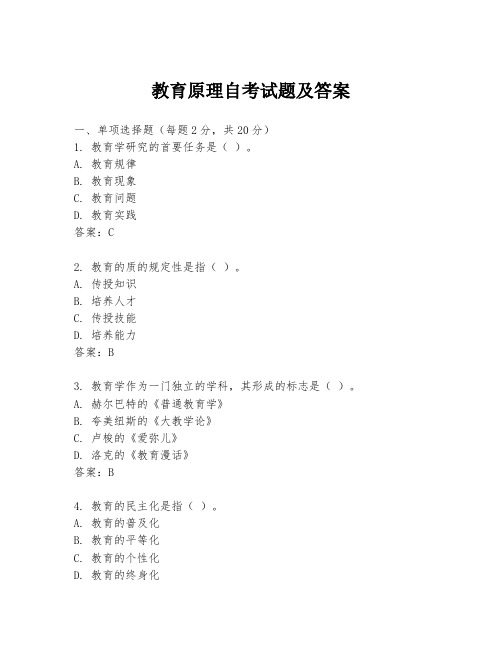
教育原理自考试题及答案一、单项选择题(每题2分,共20分)1. 教育学研究的首要任务是()。
A. 教育规律B. 教育现象C. 教育问题D. 教育实践答案:C2. 教育的质的规定性是指()。
A. 传授知识B. 培养人才C. 传授技能D. 培养能力答案:B3. 教育学作为一门独立的学科,其形成的标志是()。
A. 赫尔巴特的《普通教育学》B. 夸美纽斯的《大教学论》C. 卢梭的《爱弥儿》D. 洛克的《教育漫话》答案:B4. 教育的民主化是指()。
A. 教育的普及化B. 教育的平等化C. 教育的个性化D. 教育的终身化答案:B5. 教育的终身化是指()。
A. 教育的普及化B. 教育的平等化C. 教育的个性化D. 教育的民主化答案:A6. 教育的个性化是指()。
A. 教育的普及化B. 教育的平等化C. 教育的民主化D. 教育的终身化答案:C7. 教育的创新性是指()。
A. 教育的普及化B. 教育的平等化C. 教育的个性化D. 教育的民主化答案:C8. 教育的公平性是指()。
A. 教育的普及化B. 教育的平等化C. 教育的个性化D. 教育的终身化答案:B9. 教育的终身化是指()。
A. 教育的普及化B. 教育的平等化C. 教育的个性化D. 教育的民主化答案:A10. 教育的民主化是指()。
A. 教育的普及化B. 教育的平等化C. 教育的个性化D. 教育的终身化答案:B二、多项选择题(每题3分,共15分)1. 教育学研究的内容主要包括()。
A. 教育理论B. 教育实践C. 教育政策D. 教育方法答案:ABCD2. 教育的功能主要包括()。
A. 社会功能B. 个体发展功能C. 经济功能D. 文化功能答案:ABCD3. 教育的基本原则包括()。
A. 教育公平B. 教育民主C. 教育创新D. 教育个性化答案:ABCD4. 教育的发展趋势包括()。
A. 教育信息化B. 教育国际化C. 教育终身化D. 教育个性化答案:ABCD5. 教育的改革方向包括()。
4月自学考试00469教育学原理试题答案
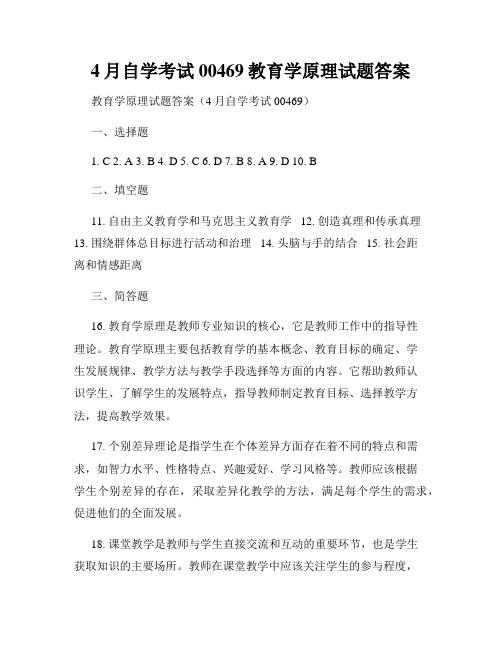
4月自学考试00469教育学原理试题答案教育学原理试题答案(4月自学考试00469)一、选择题1. C2. A3. B4. D5. C6. D7. B8. A9. D 10. B二、填空题11. 自由主义教育学和马克思主义教育学 12. 创造真理和传承真理13. 围绕群体总目标进行活动和治理 14. 头脑与手的结合 15. 社会距离和情感距离三、简答题16. 教育学原理是教师专业知识的核心,它是教师工作中的指导性理论。
教育学原理主要包括教育学的基本概念、教育目标的确定、学生发展规律、教学方法与教学手段选择等方面的内容。
它帮助教师认识学生、了解学生的发展特点,指导教师制定教育目标、选择教学方法,提高教学效果。
17. 个别差异理论是指学生在个体差异方面存在着不同的特点和需求,如智力水平、性格特点、兴趣爱好、学习风格等。
教师应该根据学生个别差异的存在,采取差异化教学的方法,满足每个学生的需求,促进他们的全面发展。
18. 课堂教学是教师与学生直接交流和互动的重要环节,也是学生获取知识的主要场所。
教师在课堂教学中应该关注学生的参与程度,采用积极互动的教学方法,提供学生互动的机会,激发学生的学习兴趣和积极性。
19. 教育技术是指教师在教学中运用各种工具和技术手段来促进学生学习的过程。
教育技术包括教学设计、多媒体教学、网络教学、教学评价等方面的内容。
教师应该灵活运用教育技术,创造有利于学生学习的环境和条件。
四、论述题教育学原理是教师发展的基础和指导性理论。
教师在工作中需要掌握教育学原理,以便更好地进行教学活动。
首先,教育学原理帮助教师认识学生,了解学生的发展特点,从而更好地适应学生的需求。
比如,教师可以根据学生的认知水平和学习能力,选择合适的教学方法和手段,提高教学效果。
其次,教育学原理还指导教师制定教育目标,明确教学的目的和方向。
教育学原理帮助教师明确教育的目标是培养学生的全面素质和能力,促进学生的发展。
最后,教育学原理还对教师的教学方法和教学手段提供了指导。
00469教育学原理201101真题及答案
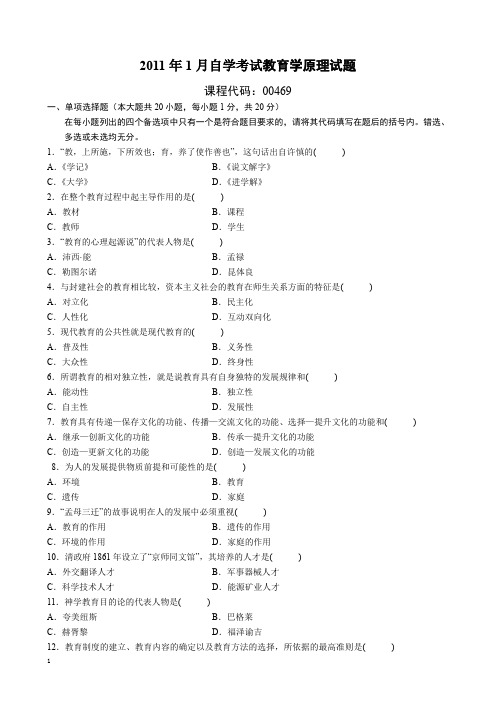
2011年1月自学考试教育学原理试题课程代码:00469一、单项选择题(本大题共20小题,每小题1分,共20分)在每小题列出的四个备选项中只有一个是符合题目要求的,请将其代码填写在题后的括号内。
错选、多选或未选均无分。
1.“教,上所施,下所效也;育,养了使作善也”,这句话出自许慎的( )A.《学记》B.《说文解字》C.《大学》D.《进学解》2.在整个教育过程中起主导作用的是( )A.教材B.课程C.教师D.学生3.“教育的心理起源说”的代表人物是( )A.沛西·能B.孟禄C.勒图尔诺D.昆体良4.与封建社会的教育相比较,资本主义社会的教育在师生关系方面的特征是( )A.对立化B.民主化C.人性化D.互动双向化5.现代教育的公共性就是现代教育的( )A.普及性B.义务性C.大众性D.终身性6.所谓教育的相对独立性,就是说教育具有自身独特的发展规律和( )A.能动性B.独立性C.自主性D.发展性7.教育具有传递—保存文化的功能、传播—交流文化的功能、选择—提升文化的功能和( )A.继承—创新文化的功能B.传承—提升文化的功能C.创造—更新文化的功能D.创造—发展文化的功能8.为人的发展提供物质前提和可能性的是( )A.环境B.教育C.遗传D.家庭9.“孟母三迁”的故事说明在人的发展中必须重视( )A.教育的作用B.遗传的作用C.环境的作用D.家庭的作用10.清政府1861年设立了“京师同文馆”,其培养的人才是( )A.外交翻译人才B.军事器械人才C.科学技术人才D.能源矿业人才11.神学教育目的论的代表人物是( )A.夸美纽斯B.巴格莱C.赫胥黎D.福泽谕吉12.教育制度的建立、教育内容的确定以及教育方法的选择,所依据的最高准则是( )A.教育目的B.教育方针C.教育原则D.教育规律13.在学校教育中,教育内容从形式上看就是所谓的“课程”,它包括( )A.主干课程和辅助课程B.综合课程和活动课程C.显性课程和隐性课程D.必修课程和选修课程14.德育的个体享用性功能所建立的德育模式是( )A.乐教和乐学模式B.学习和生活模式C.审美和立美模式D.认知和体验模式15.从教育过程的构成要素来看,教育过程是( )A.教授过程与学习过程的对立统一B.学习过程与发展过程的对立统一C.教授过程与发展过程的对立统一D.教育过程与教学过程的对立统一16.教育过程的主要矛盾是( )A.传授知识和能力发展之间的矛盾B.教授和学习之间的矛盾C.教育活动的培养目标和学生发展实际之间的矛盾D.教师和学生之间的矛盾17.“十年树木,百年树人”这句话说明教师劳动具有( )A.间接性B.连续性C.复杂性D.长期性18.学龄中期的年龄阶段是( )A.2、3岁~6、7岁B.6、7岁~11、12岁C.11、12岁~14、15岁D.14、15岁~17、18岁19.家庭教育主要是在日常生活中自然而然地进行,这表明家庭教育具有( )A.情感化特点B.多样化特点C.复杂化特点D.生活化特点20.家庭教育的两种类别是直接的教育和( )A.间接的教育B.母亲的教育C.父亲的教育D.父母亲的教育二、名词解释题(本大题共5小题,每小题4分,共20分)21.教育的社会制约性22.人的可教育性23.教育美育24.奖惩法25.教师中心论三、简答题(本大题共6小题,选答其中4小题,每小题8分,共32分,多选答者,按前4小题评分) 26.简述在教学中如何发展学生的智力。
专升本00469教育学原理历年试题题库(考试必备)
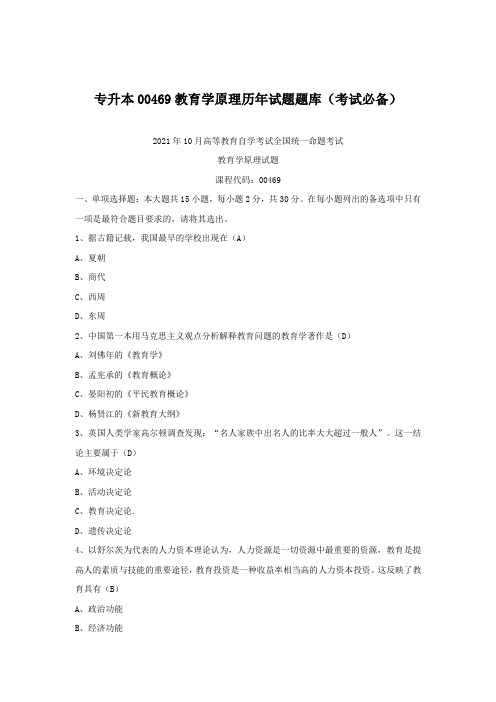
专升本00469教育学原理历年试题题库(考试必备)2021年10月高等教育自学考试全国统一命题考试教育学原理试题课程代码:00469一、单项选择题:本大题共15小题,每小题2分,共30分。
在每小题列出的备选项中只有一项是最符合题目要求的,请将其选出。
1、据古籍记载,我国最早的学校出现在(A)A、夏朝B、商代C、西周D、东周2、中国第一本用马克思主义观点分析解释教育问题的教育学著作是(D)A、刘佛年的《教育学》B、孟宪承的《教育概论》C、晏阳初的《平民教育概论》D、杨贤江的《新教育大纲》3、英国人类学家高尔顿调查发现:“名人家族中出名人的比率大大超过一般人”。
这一结论主要属于(D)A、环境决定论B、活动决定论C、教育决定论.D、遗传决定论4、以舒尔茨为代表的人力资本理论认为,人力资源是一切资源中最重要的资源,教育是提高人的素质与技能的重要途径,教育投资是一种收益率相当高的人力资本投资。
这反映了教育具有(B)A、政治功能B、经济功能C、文化功能D、享用功能5、关于教育的目的,学者们见仁见智。
有的坚持个人本位论,有的主张社会本位论。
其中主张个人本位论的学者是(C)A、凯兴斯坦纳B、涂尔干C、卢梭D、柏拉图6、现代教育制度诞生的标志是(B)A、书院的出现B、义务教育的实施C、班级教学的出现D、大学的出现7、在学生教育地位的问题上,德国教育学者赫尔巴特所持的观点属于(D)A、主导主体论B、师生双主体论C、学生中心论D、教师中心论8、在教师专业知识中,教育学知识、心理学知识及学科教学法知识属于(D)A、本体性知识B、实践性知识C、条件性知识D、基础性知识9、一般情况下,当人们说到教师的社会地位时,往往是指教师整体的社会地位,具体体现为(C)A、政治地位、经济地位、法律地位和专业地位B、政治地位、经济地位、文化地位和专业地位C、政治地位、经济地位、法律地位和文化地位D、文化地位、经济地位、法律地位和专业地位10、李老师非常重视教室墙壁的布置,分区域张贴了名人名言、学生守则、校风、校训等。
教育学原理(00469)练习册选择题
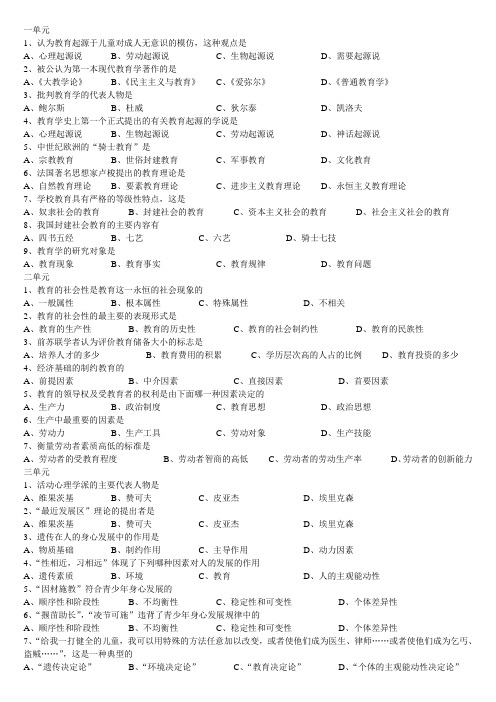
1、认为教育起源于儿童对成人无意识的模仿,这种观点是A、心理起源说B、劳动起源说C、生物起源说D、需要起源说2、被公认为第一本现代教育学著作的是A、《大教学论》B、《民主主义与教育》C、《爱弥尔》D、《普通教育学》3、批判教育学的代表人物是A、鲍尔斯B、杜威C、狄尔泰D、凯洛夫4、教育学史上第一个正式提出的有关教育起源的学说是A、心理起源说B、生物起源说C、劳动起源说D、神话起源说5、中世纪欧洲的“骑士教育”是A、宗教教育B、世俗封建教育C、军事教育D、文化教育6、法国著名思想家卢梭提出的教育理论是A、自然教育理论B、要素教育理论C、进步主义教育理论D、永恒主义教育理论7、学校教育具有严格的等级性特点,这是A、奴隶社会的教育B、封建社会的教育C、资本主义社会的教育D、社会主义社会的教育8、我国封建社会教育的主要内容有A、四书五经B、七艺C、六艺D、骑士七技9、教育学的研究对象是A、教育现象B、教育事实C、教育规律D、教育问题二单元1、教育的社会性是教育这一永恒的社会现象的A、一般属性B、根本属性C、特殊属性D、不相关2、教育的社会性的最主要的表现形式是A、教育的生产性B、教育的历史性C、教育的社会制约性D、教育的民族性3、前苏联学者认为评价教育储备大小的标志是A、培养人才的多少B、教育费用的积累C、学历层次高的人占的比例D、教育投资的多少4、经济基础的制约教育的A、前提因素B、中介因素C、直接因素D、首要因素5、教育的领导权及受教育者的权利是由下面哪一种因素决定的A、生产力B、政治制度C、教育思想D、政治思想6、生产中最重要的因素是A、劳动力B、生产工具C、劳动对象D、生产技能7、衡量劳动者素质高低的标准是A、劳动者的受教育程度B、劳动者智商的高低C、劳动者的劳动生产率D、劳动者的创新能力三单元1、活动心理学派的主要代表人物是A、维果茨基B、赞可夫C、皮亚杰D、埃里克森2、“最近发展区”理论的提出者是A、维果茨基B、赞可夫C、皮亚杰D、埃里克森3、遗传在人的身心发展中的作用是A、物质基础B、制约作用C、主导作用D、动力因素4、“性相近,习相远”体现了下列哪种因素对人的发展的作用A、遗传素质B、环境C、教育D、人的主观能动性5、“因材施教”符合青少年身心发展的A、顺序性和阶段性B、不均衡性C、稳定性和可变性D、个体差异性6、“揠苗助长”,“凌节可施”违背了青少年身心发展规律中的A、顺序性和阶段性B、不均衡性C、稳定性和可变性D、个体差异性7、“给我一打健全的儿童,我可以用特殊的方法任意加以改变,或者使他们成为医生、律师……或者使他们成为乞丐、盗贼……”,这是一种典型的A、“遗传决定论”B、“环境决定论”C、“教育决定论”D、“个体的主观能动性决定论”1、“勤奋好学”在教育制度中属于A、正式教育制度B、非正式教育制度C、显性教育制度D、隐性教育制度2、整个教育制度中处于核心位置的是A、学校教育制度B、电化教育制度C、社会教育制度D、企业教育制度3、建立独具特色的军事教育制度的国家是A、日本B、印度C、斯巴达D、希腊4、在古罗马学校教育制度中为平民子弟准备的学校是A、施乐学校B、中等学校C、修辞学校D、高等学校5、在西欧教会学校中,“僧院学校”与“天主教学校”的教学内容主要是神学和A、七技B、六艺C、七艺D、文法6、使英国现代学制最终确立的文件是A、怀特布雷提案B、巴特勒教育法案C、初等教育法案D、中等教育法案7、促成德国双轨制初步形成的是A、路德学校改革运动B、《乡村学校规程》的颁布C、赫克开办“经济学教学学科中学”D、中等教育法案8、使美国初步实现了或从形式上实现了“教育机会均等”原则的是A、富兰克林的实科性质的学院B、义务教育法C、八四四学制D、六三三学制9、我国近代第一个在全国颁布实施的现代学制是A、癸卯学制B、壬寅学制C、壬戌学制D、壬子—癸丑学制五单元1、人的体质是A、创造性B、主观能动性C、意识D、一切社会关系的总和2、主张应根据个体发展的需要确定教育目的的观点属于A、神学教育目的论B、个人本位的教育目的论C、社会本位的教育目的论D、教育无目的论3、下列属于教育目的功能的是A、导向功能B、系统功能C、信息功能D、程序功能4、持个人本位教育目的论的教育学家有A、诺笃尔普B、福禄倍尔C、涂尔干D、凯兴斯泰纳5、社会生产力是人的全面发展的A、重要前提B、决定因素C、重要条件D、重要中介6、持社会本位的教育目的论的学者是A、卢梭B、涂尔干C、杜威D、夸美纽斯7、孟子认为“学问之道无他,求其放心而已”,荀子则持“积礼义而为君子”的观点。
2010年教育学真题及参考答案

2010教育学统考部分真题及参考答案二、辨析题:46~48小题,每小题15分。
共45分。
要求判断正误并着重阐明理由。
请将答案写在答题纸指定位置上。
46、教学是教师有目的、有计划地促进学生掌握知识和技能的过程。
47、课程即学校开设的全部学科的总和。
48、智力是创造力的充要条件。
三、简答题:49~53小题,每小题15分,共75分。
请将答案写在答题纸指定位置上。
49、简述学校教育对学生的发展发挥主导作用的条件。
50、简述杨贤江“全人生的指导”的目标和内容。
51、简述赫尔巴特的教学形式阶段理论。
52、简述奥苏伯尔有意义学习的实质与条件。
53、列举列举教育研究假设的三种分类方式,并简述假设表述基本要求。
四、分析论述题:54~56小题,每小题30.共90分。
请将答案写在答题纸指定位置上。
54、美国经济学家桑德伯格曾经对经济增长与教育的关系进行跨国的动态比较。
他以欧洲各国1950年的成人识字率表示人力资本存量,然后动态比较1913年和1970年人均国民收入的变化。
其统计结果如表。
(图表略)(1)根据表中数据说明教育对经济发展的影响及其特点;(2)运用相关原理分析产生这种教育影响及其特点的原因。
55、试从指导思想和改革措施两方面比较中国洋务教育与日本明治维新教育改革。
56、本题为选做题部分,请在Ⅰ、Ⅱ两道题中任选一道作答。
如果两题都答,只按第Ⅰ道题的成绩计入总分。
Ⅰ、阅读下述案例,回答问题。
对于学生在课堂上的违规行为,老师可能采用各种不同的办法进行处理。
下面是5个实例。
例一学生张明在课堂上对邻座做鬼脸,引起对方发笑,老师对其注视片刻后,即不再理睬,机械讲课,学生遂终止其不当行为。
例二当学生的违规行为获得部分学生认可时,让违规学生坐到教室后边,与其他学生分开,有效地阻止了学生的违规行为。
例三刚上课时,郭忠抽掉前座李军的椅子,李军重重地摔了一跤,老师当即严肃的批评了郭忠,并令其放学后到老师办公室写情况说明。
例四课间有两个学生吵架,前来上课的老师厉声制止,毫无效果,围观的学生越来越多。
教育学原理简答题及答案(自考00469)
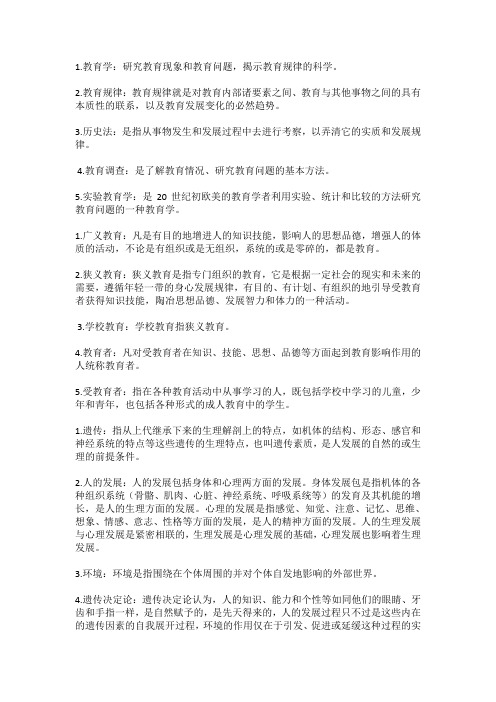
1.教育学:研究教育现象和教育问题,揭示教育规律的科学。
2.教育规律:教育规律就是对教育内部诸要素之间、教育与其他事物之间的具有本质性的联系,以及教育发展变化的必然趋势。
3.历史法:是指从事物发生和发展过程中去进行考察,以弄清它的实质和发展规律。
4.教育调查:是了解教育情况、研究教育问题的基本方法。
5.实验教育学:是20世纪初欧美的教育学者利用实验、统计和比较的方法研究教育问题的一种教育学。
1.广义教育:凡是有目的地增进人的知识技能,影响人的思想品德,增强人的体质的活动,不论是有组织或是无组织,系统的或是零碎的,都是教育。
2.狭义教育:狭义教育是指专门组织的教育,它是根据一定社会的现实和未来的需要,遵循年轻一带的身心发展规律,有目的、有计划、有组织的地引导受教育者获得知识技能,陶冶思想品德、发展智力和体力的一种活动。
3.学校教育:学校教育指狭义教育。
4.教育者:凡对受教育者在知识、技能、思想、品德等方面起到教育影响作用的人统称教育者。
5.受教育者:指在各种教育活动中从事学习的人,既包括学校中学习的儿童,少年和青年,也包括各种形式的成人教育中的学生。
1.遗传:指从上代继承下来的生理解剖上的特点,如机体的结构、形态、感官和神经系统的特点等这些遗传的生理特点,也叫遗传素质,是人发展的自然的或生理的前提条件。
2.人的发展:人的发展包括身体和心理两方面的发展。
身体发展包是指机体的各种组织系统(骨骼、肌肉、心脏、神经系统、呼吸系统等)的发育及其机能的增长,是人的生理方面的发展。
心理的发展是指感觉、知觉、注意、记忆、思维、想象、情感、意志、性格等方面的发展,是人的精神方面的发展。
人的生理发展与心理发展是紧密相联的,生理发展是心理发展的基础,心理发展也影响着生理发展。
3.环境:环境是指围绕在个体周围的并对个体自发地影响的外部世界。
4.遗传决定论:遗传决定论认为,人的知识、能力和个性等如同他们的眼睛、牙齿和手指一样,是自然赋予的,是先天得来的,人的发展过程只不过是这些内在的遗传因素的自我展开过程,环境的作用仅在于引发、促进或延缓这种过程的实现。
全国2012年1月高等教育自学考试 教育学原理试题 课程代码00469
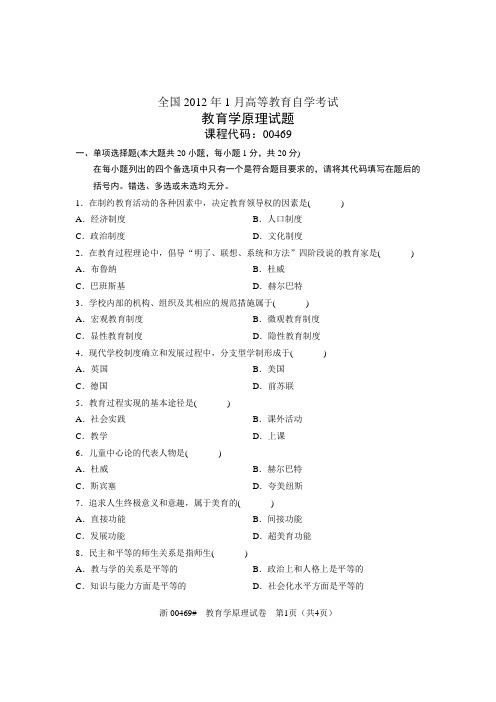
全国2012年1月高等教育自学考试教育学原理试题课程代码:00469一、单项选择题(本大题共20小题,每小题1分,共20分)在每小题列出的四个备选项中只有一个是符合题目要求的,请将其代码填写在题后的括号内。
错选、多选或未选均无分。
1.在制约教育活动的各种因素中,决定教育领导权的因素是( )A.经济制度B.人口制度C.政治制度D.文化制度2.在教育过程理论中,倡导“明了、联想、系统和方法”四阶段说的教育家是( ) A.布鲁纳B.杜威C.巴班斯基D.赫尔巴特3.学校内部的机构、组织及其相应的规范措施属于( )A.宏观教育制度B.微观教育制度C.显性教育制度D.隐性教育制度4.现代学校制度确立和发展过程中,分支型学制形成于( )A.英国B.美国C.德国D.前苏联5.教育过程实现的基本途径是( )A.社会实践B.课外活动C.教学D.上课6.儿童中心论的代表人物是( )A.杜威B.赫尔巴特C.斯宾塞D.夸美纽斯7.追求人生终极意义和意趣,属于美育的( )A.直接功能B.间接功能C.发展功能D.超美育功能8.民主和平等的师生关系是指师生( )A.教与学的关系是平等的B.政治上和人格上是平等的C.知识与能力方面是平等的D.社会化水平方面是平等的浙00469#教育学原理试卷第1页(共4页)9.在各种各样的教育制度中,处于核心位置的是( )A.学校教育制度B.教育行政制度C.课程制度D.教学制度10.人的身心发展的物质前提是( )A.家庭B.环境C.教育D.遗传11.根据《中华人民共和国义务教育法》等法律规定,义务教育和基础教育阶段,学校教育必须做到“两个全面”,即( )A.“全面教育”与“全面发展”B.“全面发展”与“面向全体”C.“全面教育”与“面向全体”D.“全面教育”与“全面落实”12.西方古代最早的学校教育制度中最为典型的是雅典教育制度和( )A.斯巴达教育制度B.古罗马教育制度C.古希腊教育制度D.古巴比伦教育制度13.学校教育的基本要素是教育者、受教育者和( )A.教育内容B.教育手段C.教育影响D.教育方法14.所谓狭义的美育,其极端形式为( )A.美感教育B.审美教育C.艺术教育D.审美立美教育15.皮亚杰认为,儿童认知发展可以划分为四个时期:感觉运动时期、前运算时期、具体运算时期和( )A.形式运算时期B.抽象运算时期C.后运算时期D.逻辑运算时期16.学校体育的基本特征是教育性、技能性和( )A.计划性B.竞技性C.运动性D.娱乐性17.凯兴斯泰纳倡导( )A.教育无目的论B.个人本位的目的论C.社会本位的目的论D.神学教育目的论18.《林哈德和葛笃德》的作者是( )浙00469#教育学原理试卷第2页(共4页)A.培根B.裴斯特洛齐C.夸美纽斯D.卢梭19.使人的全面发展成为可能的物质基础是( )A.机器大生产B.传统手工业C.独立手工业D.工场手工业20.教育的根本属性是( )A.社会制约性B.社会性C.历史性D.相对独立性二、名词解释题(本大题共4小题,每小题4分,共16分)21.现代教育的科学性22.陶冶法23.教育的生物起源说24.环境三、简答题(本大题共5小题,每小题7分,共35分)25.简述教师素养中知识结构的组成部分。
教育学原理(00469)练习册名词解释
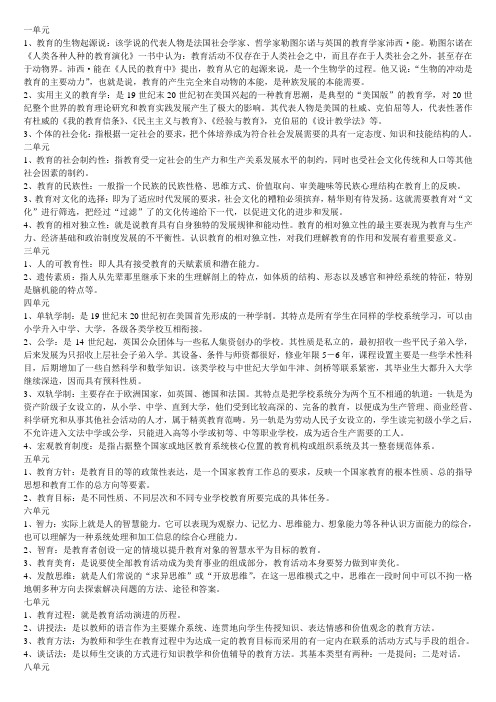
一单元1、教育的生物起源说:该学说的代表人物是法国社会学家、哲学家勒图尔诺与英国的教育学家沛西·能。
勒图尔诺在《人类各种人种的教育演化》一书中认为:教育活动不仅存在于人类社会之中,而且存在于人类社会之外,甚至存在于动物界。
沛西·能在《人民的教育中》提出,教育从它的起源来说,是一个生物学的过程。
他又说:“生物的冲动是教育的主要动力”,也就是说,教育的产生完全来自动物的本能,是种族发展的本能需要。
2、实用主义的教育学:是19世纪末20世纪初在美国兴起的一种教育思潮,是典型的“美国版”的教育学,对20世纪整个世界的教育理论研究和教育实践发展产生了极大的影响。
其代表人物是美国的杜威、克伯屈等人,代表性著作有杜威的《我的教育信条》、《民主主义与教育》、《经验与教育》,克伯屈的《设计教学法》等。
3、个体的社会化:指根据一定社会的要求,把个体培养成为符合社会发展需要的具有一定态度、知识和技能结构的人。
二单元1、教育的社会制约性:指教育受一定社会的生产力和生产关系发展水平的制约,同时也受社会文化传统和人口等其他社会因素的制约。
2、教育的民族性:一般指一个民族的民族性格、思维方式、价值取向、审美趣味等民族心理结构在教育上的反映。
3、教育对文化的选择:即为了适应时代发展的要求,社会文化的糟粕必须摈弃,精华则有待发扬。
这就需要教育对“文化”进行筛选,把经过“过滤”了的文化传递给下一代,以促进文化的进步和发展。
4、教育的相对独立性:就是说教育具有自身独特的发展规律和能动性。
教育的相对独立性的最主要表现为教育与生产力、经济基础和政治制度发展的不平衡性。
认识教育的相对独立性,对我们理解教育的作用和发展有着重要意义。
三单元1、人的可教育性:即人具有接受教育的天赋素质和潜在能力。
2、遗传素质:指人从先辈那里继承下来的生理解剖上的特点,如体质的结构、形态以及感官和神经系统的特征,特别是脑机能的特点等。
四单元1、单轨学制:是19世纪末20世纪初在美国首先形成的一种学制。
- 1、下载文档前请自行甄别文档内容的完整性,平台不提供额外的编辑、内容补充、找答案等附加服务。
- 2、"仅部分预览"的文档,不可在线预览部分如存在完整性等问题,可反馈申请退款(可完整预览的文档不适用该条件!)。
- 3、如文档侵犯您的权益,请联系客服反馈,我们会尽快为您处理(人工客服工作时间:9:00-18:30)。
全国2010年1月高等教育自学考试
教育学原理试题课程代码:00469
一、单项选择题(本大题共20小题,每小题1分,共20分)
在每小题列出的四个备选项中只有一个是符合题目要求的,请将其代码填写在题后的括号内。
错选、多选或未选均无分。
1.学校教育的基本要素有教育者、受教育者和()
A.教育影响
B.教育手段
C.教育材料
D.教育组织形式
2.英国教育家洛克撰写的教育学著作是()
A.《大教学论》
B.《普通教育学》
C.《教育漫话》
D.《我的教育信条》
3.强调课程组织以学生的经验为中心,这个观点所体现的教育思潮是()
A.文化教育学
B.实用主义教育学
C.批判教育学
D.制度教育学
4.同一年龄阶段的儿童在同一方面发展的速度和水平各不相同,在不同方面发展的水平也各不相同,这个现象体现
了青少年身心发展的()
A.阶段性
B.个体差异性
C.可变性
D.不均衡性
5.在教育与政治的关系中,政治制度决定着教育的()
A.规模
B.领导权和受教育权
C.形式
D.方法
6.用教学的术语来说,教育制度是一种“隐性课程”,这说明教育制度的特征具有()
A.客观性
B.强制性
C.价值性
D.教育性
7.在各种教育制度中,处于整个教育制度核心位置的是()
A.高等教育制度
B.隐性教育制度
C.宏观教育制度
D.学校教育制度
8.中世纪西欧的教会学校主要有僧院学校、天主教学校和()
A.文艺学校
B.文法学校
C.教区学校
D.修辞学校
9.中国古代学校教育制度的构成主要有官学教育系统、私学教育系统和()
A.职业教育系统
B.普通教育系统
C.书院教育系统
D.社会教育系统
10.社会本位教育目的论的代表人物是()
A.涂尔干
B.卢梭
C.杜威
D.夸美纽斯
11.在学校教育中,教育内容从形式方面看就是所谓的()
A.教学
B.课程
C.智育
D.德育
12.体现德育社会性功能的中介作用是()
A.政治功能
B.生态功能
C.经济功能
D.文化功能
13.关于知识学习和智力增长的关系,教育界最主要的争论议题是()
A.通识教育和专业教育之争
B.科学教育和人文教育之争
C.实质教育和形式教育之争
D.古典教育和现代教育之争
14.美育作为相对独立的、明确的教育范畴的提出者是()
A.席勒
B.杜威
C.毛泽东
D.黑格尔
15.在教育过程阶段理论方面,提出综合考虑各种教育影响的最优化模式的教育家是()
A.夸美纽斯
B.杜威
C.维果茨基
D.巴班斯基
16.“暗示教学法”归属的教育方法是()
A.讲授法
B.陶冶法
C.奖惩法
D.谈话法
17.提倡“教师中心论”学说的代表人物是()
A.赫尔巴特
B.杜威
C.卢梭
D.福禄倍尔
18.教师劳动的特点具有()
A.机械性
B.单一性
C.示范性
D.短期性
19.初中生的生理特征是()
A.身体增长的速度开始减慢
B.性成熟
C.脑重量与成人水平相差很大
D.心脏的发展比血管的发展快
20.教师专业知识的特点是理论性、系统性、发展性和()
A.深刻性
B.抽象性
C.基础性
D.阶段性
二、名词解释题(本大题共5小题,每小题4分,共20分)
21.教育的相对独立性
22.教育的劳动起源说
23.单轨制
24.讲授法
25.学生中心论
三、简答题(本大题共6小题,选答其中4小题,每小题8分,共32分,多选答者,按前4小题评分)
26.简述资本主义社会教育的基本特征。
27.简述教育发展的继承性。
28.简述西方古代学校教育制度的基本特征。
29.简述落实我国的教育目的必须正确处理的几个关系。
30.试从时间流程简述教育过程的基本阶段及其任务。
31.简述教师的具体任务。
四、论述题(本题13分)
32.如何正确认识教学与智育的关系?
五、案例分析题(本题15分)
33.小学二年级的品德与生活课上,王老师告诉同学们要遵守国家法律制度,保护野生动物。
王老师拿出了各种图片,
向大家介绍了大熊猫、金丝猴、穿山甲等国家保护动物。
同学们都非常高兴地辨识这些图片,了解到了保护动物的常识。
两周后的一个周末,小明和家人去郊外游玩,在一个农庄吃饭的时候,家人点了清蒸穿山甲。
小明说:“穿山甲不能吃,我们上课的时候老师说了,它是国家二级保护动物,吃它是违法的。
”小明的爸爸说:“别听你老师说的,穿山甲当然可以吃了,而且还很有营养。
”旁边的服务员听到父子俩的谈话,也纷纷附和小明的爸爸。
周一上学,小明疑惑地问王老师:“老师,为什么您叫我们不能伤害穿山甲,可是爸爸却说穿山甲营养丰富,吃了对身
体好。
我到底应该听谁的呢?”
请运用学校、家庭、社会三结合形成教育合力的理论来分析上述案例,并提出解决途径。
